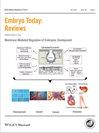Tobias Starborg, Karl E. Kadler
下载PDF
{"title":"连续块面扫描电子显微镜:在细胞-基质界面研究胚胎发育的工具","authors":"Tobias Starborg, Karl E. Kadler","doi":"10.1002/bdrc.21087","DOIUrl":null,"url":null,"abstract":"<p>Studies of gene regulation, signaling pathways, and stem cell biology are contributing greatly to our understanding of early embryonic vertebrate development. However, much less is known about the events during the latter half of embryonic development, when tissues comprising mostly extracellular matrix (ECM) are formed. The matrix extends far beyond the boundaries of individual cells and is refractory to study by conventional biochemical and molecular techniques; thus major gaps exist in our knowledge of the formation and three-dimensional (3D) organization of the dense tissues that form the bulk of adult vertebrates. Serial block face-scanning electron microscopy (SBF-SEM) has the ability to image volumes of tissue containing numerous cells at a resolution sufficient to study the organization of the ECM. Furthermore, whereas light microscopy was once relatively straightforward and electron microscopy was performed in specialist laboratories, the tables are turned; SBF-SEM is relatively straightforward and is becoming routine in high-end resolution studies of embryonic structures <i>in vivo</i>. In this review, we discuss the emergence of SBF-SEM as a tool for studying embryonic vertebrate development. Birth Defects Research (Part C) 105:9–18, 2015. © 2015 Wiley Periodicals, Inc.</p>","PeriodicalId":55352,"journal":{"name":"Birth Defects Research Part C-Embryo Today-Reviews","volume":"105 1","pages":"9-18"},"PeriodicalIF":0.0000,"publicationDate":"2015-03-26","publicationTypes":"Journal Article","fieldsOfStudy":null,"isOpenAccess":false,"openAccessPdf":"https://sci-hub-pdf.com/10.1002/bdrc.21087","citationCount":"25","resultStr":"{\"title\":\"Serial block face-scanning electron microscopy: A tool for studying embryonic development at the cell–matrix interface\",\"authors\":\"Tobias Starborg, Karl E. Kadler\",\"doi\":\"10.1002/bdrc.21087\",\"DOIUrl\":null,\"url\":null,\"abstract\":\"<p>Studies of gene regulation, signaling pathways, and stem cell biology are contributing greatly to our understanding of early embryonic vertebrate development. However, much less is known about the events during the latter half of embryonic development, when tissues comprising mostly extracellular matrix (ECM) are formed. The matrix extends far beyond the boundaries of individual cells and is refractory to study by conventional biochemical and molecular techniques; thus major gaps exist in our knowledge of the formation and three-dimensional (3D) organization of the dense tissues that form the bulk of adult vertebrates. Serial block face-scanning electron microscopy (SBF-SEM) has the ability to image volumes of tissue containing numerous cells at a resolution sufficient to study the organization of the ECM. Furthermore, whereas light microscopy was once relatively straightforward and electron microscopy was performed in specialist laboratories, the tables are turned; SBF-SEM is relatively straightforward and is becoming routine in high-end resolution studies of embryonic structures <i>in vivo</i>. In this review, we discuss the emergence of SBF-SEM as a tool for studying embryonic vertebrate development. Birth Defects Research (Part C) 105:9–18, 2015. © 2015 Wiley Periodicals, Inc.</p>\",\"PeriodicalId\":55352,\"journal\":{\"name\":\"Birth Defects Research Part C-Embryo Today-Reviews\",\"volume\":\"105 1\",\"pages\":\"9-18\"},\"PeriodicalIF\":0.0000,\"publicationDate\":\"2015-03-26\",\"publicationTypes\":\"Journal Article\",\"fieldsOfStudy\":null,\"isOpenAccess\":false,\"openAccessPdf\":\"https://sci-hub-pdf.com/10.1002/bdrc.21087\",\"citationCount\":\"25\",\"resultStr\":null,\"platform\":\"Semanticscholar\",\"paperid\":null,\"PeriodicalName\":\"Birth Defects Research Part C-Embryo Today-Reviews\",\"FirstCategoryId\":\"1085\",\"ListUrlMain\":\"https://onlinelibrary.wiley.com/doi/10.1002/bdrc.21087\",\"RegionNum\":0,\"RegionCategory\":null,\"ArticlePicture\":[],\"TitleCN\":null,\"AbstractTextCN\":null,\"PMCID\":null,\"EPubDate\":\"\",\"PubModel\":\"\",\"JCR\":\"Q\",\"JCRName\":\"Medicine\",\"Score\":null,\"Total\":0}","platform":"Semanticscholar","paperid":null,"PeriodicalName":"Birth Defects Research Part C-Embryo Today-Reviews","FirstCategoryId":"1085","ListUrlMain":"https://onlinelibrary.wiley.com/doi/10.1002/bdrc.21087","RegionNum":0,"RegionCategory":null,"ArticlePicture":[],"TitleCN":null,"AbstractTextCN":null,"PMCID":null,"EPubDate":"","PubModel":"","JCR":"Q","JCRName":"Medicine","Score":null,"Total":0}
引用次数: 25
引用
批量引用

 求助内容:
求助内容: 应助结果提醒方式:
应助结果提醒方式:


